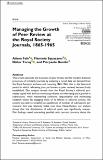Files in this item
Managing the growth of peer review at the Royal Society journals, 1865-1965
Item metadata
| dc.contributor.author | Fyfe, Aileen | |
| dc.contributor.author | Squazzoni, Flaminio | |
| dc.contributor.author | Torny, Didier | |
| dc.contributor.author | Dondio, Pierpaolo | |
| dc.date.accessioned | 2019-07-17T14:30:06Z | |
| dc.date.available | 2019-07-17T14:30:06Z | |
| dc.date.issued | 2020-05-01 | |
| dc.identifier | 259114733 | |
| dc.identifier | 1f3112b6-62bf-4465-aa96-759d0c969907 | |
| dc.identifier | 000478254300001 | |
| dc.identifier | 85070331405 | |
| dc.identifier.citation | Fyfe , A , Squazzoni , F , Torny , D & Dondio , P 2020 , ' Managing the growth of peer review at the Royal Society journals, 1865-1965 ' , Science, Technology, and Human Values , vol. 45 , no. 3 , pp. 405-429 . https://doi.org/10.1177/0162243919862868 | en |
| dc.identifier.issn | 0162-2439 | |
| dc.identifier.other | ORCID: /0000-0002-6794-4140/work/59698788 | |
| dc.identifier.uri | https://hdl.handle.net/10023/18111 | |
| dc.description | This collaboration was supported by the COST Action TD1306 “New Frontiers of Peer Review” (PEERE). The historical research for this paper was supported by the UK Arts & Humanities Research Council, grant AH/K001841, “Publishing the Philosophical Transactions, 1665-2015.” | en |
| dc.description.abstract | This article examines the evolution of peer review and the modern editorial processes of scholarly journals by analyzing a novel dataset derived from the Royal Society’s archives and covering 1865 to 1965, i.e., the historical period in which refereeing (not yet known as peer review) became firmly established. Our analysis reveals how the Royal Society’s editorial processes coped with both an increasing reliance on refereeing and a growth in submissions, while maintaining collective responsibility and minimizing research waste. By engaging more of its fellows in editorial activity, the society was able to establish an equilibrium of number of submissions per reviewer that was relatively stable over time. Nevertheless, our analysis shows that the distribution of editorial work was significantly uneven. Our findings reveal interesting parallels with current concerns about the scale and distribution of peer-review work and suggest the strategic importance of the management of the editorial process to achieve a creative mix of community commitment and professional responsibility that is essential in contemporary journals. | |
| dc.format.extent | 25 | |
| dc.format.extent | 771589 | |
| dc.language.iso | eng | |
| dc.relation.ispartof | Science, Technology, and Human Values | en |
| dc.subject | Peer review | en |
| dc.subject | Scholarly journals | en |
| dc.subject | Editorial work | en |
| dc.subject | Royal Society | en |
| dc.subject | Responsibility | en |
| dc.subject | D History (General) | en |
| dc.subject | H Social Sciences | en |
| dc.subject | Z665 Library Science. Information Science | en |
| dc.subject | NDAS | en |
| dc.subject | BDC | en |
| dc.subject | R2C | en |
| dc.subject.lcc | D1 | en |
| dc.subject.lcc | H | en |
| dc.subject.lcc | Z665 | en |
| dc.title | Managing the growth of peer review at the Royal Society journals, 1865-1965 | en |
| dc.type | Journal article | en |
| dc.contributor.sponsor | Arts and Humanities Research Council | en |
| dc.contributor.institution | University of St Andrews. School of History | en |
| dc.identifier.doi | 10.1177/0162243919862868 | |
| dc.description.status | Peer reviewed | en |
| dc.identifier.grantnumber | AH/K001841/1 | en |
This item appears in the following Collection(s)
Items in the St Andrews Research Repository are protected by copyright, with all rights reserved, unless otherwise indicated.

